General Cougar Information:
Cougar, Mountain lion, puma, panther, catamount, Puma concolor: many generations of islanders have spoken these names with a mixture of admiration, curiosity, and fear.
In 1891, the steamer Lola dropped Oliver Van Olinda at Langill’s Landing on Colvos Passage for the first time and from there he walked up to Center. Later he recorded his reaction:
“I came from the great prairies of Nebraska and, as I walked up to Center in the gathering dusk of a mid-August evening, giant fir trees towering three hundred feet above me on either side of the trail in an almost impenetrable wall and flanked by great banks of ferns, the beauty of the scene was overshadowed by the thought that such environment simply must harbor hoards of bears and catamounts [19th Century term for cougar]. “
In Isle of the Sea Breezers Roland Carey writes, “Since the island was first inhabited, a legendary cougar has been seen, heard, tracked, and imagined, as often as the famed sasquatch has been glimpsed in other regions.”
More recently, islanders of the 2016 generation have been equally perplexed, entertained, and cautious of the most recent cougar visitor. We have put together the following page to provide more island specific information for residents. Cougars are part of our diverse wildlife and seeing one should be a rewarding and exciting experience. We hope that the information on this page helps us all learn more about these occasional island inhabitants.
Watch WDFW’s talk on Vashon: From backyards to mountaintops: large carnivore ecology in western Washington’s diverse landscapes
Thank you to Peter Ray and VOV for video-taping this talk for us.
If you need to report an incident with a cougar on Vashon:
To report poaching in progress/emergency wildlife/present danger/weekends: call 911 and ask for state patrol
To report non-emergency poaching or dangerous wildlife complaints: 877-933-9874
Large Carnivore Information pamphlet–tips for living with cougars, bears, and coyotes on Vashon.
Cougar sightings for the last 101 years: 1915-2017
SIGHTINGS 2017:
Visit our wildlife sightings page for current confirmed reports of cougar.
Historical sightings:
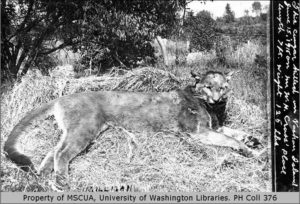
Cougar killed by Dan Lander at Cross Landing in 1915. Photo courtesy of: University of Washington Special Collections
- 1915–Cougar killed at Cross Landing by Dan Lander. The following August an extermination campaign is run to eliminate cougars from Vashon, no one knows how successful it was.
- 1919–Harbor Heights cougar sighting, reported in 1920 Island News Record.
- 1920–Harbor Heights cougar reportedly kills some chickens. Reported in Island News Record.
- 1924–Stephen Lander shoots cougar 3/4 miles away from Dan Lander’s shooting in 1915. Reported in Island News Record.
- 2011– 2-3 reports of cougar sightings in Ellisport Canyon area reported to T Martino of Wolftown.
- 2015–1 sighting of a cougar near Reddings beach/Cross Landing reported to Vashon Nature Center. Motion sensors cameras installed but nothing detected after first sighting.
- 2016–Several sightings, a few of which are confirmed with tracks or animal photos, throughout the island.
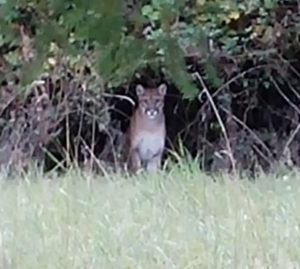
Maury cougar photographed in September of 2016 near Manzanita Beach by islander Jesse Bell.
Based on time of year most cougar sightings occur on Vashon (late spring-summer) we believe that most cougars are traveling males dispersing from their natal territories and swimming across to our shores. They use our islands for a few days to several months, as a stepping stone to larger territory. According to a 1995 research article from University of California Berkeley, “dispersing males occupy a series of small temporary home ranges, usually near urban-wildlife interfaces.” Our island is likely one of these interfaces for Washington state cougars.
FAQs
Mountain lions are fascinating animals. Elusive, silent, and strong, they have evolved for over 35 million years to be one of the most efficient predators on earth. Just learning about their anatomy, physiology, and behavior engenders respect for these beautiful wild mammals. Below we share some answers to frequently asked questions that we field regularly at Vashon Nature Center.
How do mountain lions get here?
They swim! Cougars are good swimmers and have made it to the island many times in the past. Other islands throughout the Salish Sea also experience regular cougar visits, from the Broken Island group off the West Coast of Vancouver Island to BC’s more sheltered Gulf Islands. Bainbridge and Whidbey Islands also have records of cougar sightings.
When will the most current mountain lion leave?
We have no idea! Usually mountain lions do not stick around our island more than a few months. However, as years go on, the deer population has increased in the absence of apex predators, which may be a factor that allows a cougar to stay here longer. Only time will tell.
Isn’t Vashon-Maury too small for a cougar?
Typical range sizes for male cougars are 50-100 square miles. Female ranges are slightly less large. Vashon is 37 square miles. We don’t know which factors are strongest in determining range size. If food density is a strong factor, a cougar may extend its stay in a small area. However, lack of mates will likely encourage movement at some point.
Are mountain lions dangerous?
If you are a deer yes. If you are a human less so, especially if you prepare yourself and your family in how to respond if you encounter a cougar (see next question). A healthy respect for cougars is important but we don’t need to be overly fearful. Mountain lions exist in every rural-urban interface in Washington and there has only been one fatal attack on humans in Washington and it occurred in 1924. We are much more likely to get hurt by deer here on the island as they cross roads into car paths. Most people in cougar country go about business as usual (think Bellingham, Issaquah, North Bend and Cougar mountain trails) however some suggestions from WDFW and Parks Canada for extra protection for those who would like it are: carry a walking stick, bear spray, or a noise maker. See more helpful tips below.
What do I do if I encounter a cougar?
Make yourself as big as possible. Pick up rocks, sticks, backpack, walking pole etc. in case you need to throw it at the cougar. Pick up small pets and children. If you have a backpack or jacket you can put it above your head to appear taller. Make sure the cougar has an escape route. Never approach a cougar or turn your back on the cougar or run away. You may back away slowly and give the cougar time to leave. Cougars are naturally curious and often they will not run but will eventually walk away in a nonchalant fashion. This is normal, it does not indicate aggressive behavior. If a cougar does approach yell and throw rocks. Fight back if attacked. Most attacks where people fight back have been thwarted. If you are concerned about walking alone through trails take a buddy or arm yourself with a walking stick. Keep pets on leash.
Please read these more detailed safety tips:
Canada Parks BC Cougar safety tips,
Washington Department of Fish and Wildlife
Co-existing with Large Carnivores pamphlet
What do mountain lions eat?
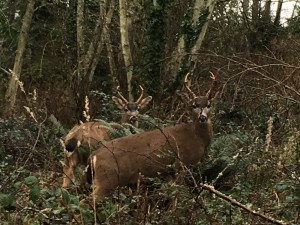
Deer are mountain lion’s preferred prey but they do eat other animals of all sizes. photo by: Kathryn True.
Mountain lions eat primarily deer, but they are opportunistic hunters and will also eat coyotes, raccoons, possums, pets, livestock (from sheep to horses), and even river otters. Unlike predators of the dog family that depend on their endurance to outrun prey, or bears that depend on brute force when hunting, cougars depend on the element of surprise. They are quick and efficient hunters waiting until prey is within 50 feet before sprinting for the attack. Once they have pounced on the back of their prey, they instantly find the vertebrae at the base of the skull and separate it with their canines, breaking the neck. Contrary to myth, they never drop directly on prey from above (as from a tree), because moving prey provides an extremely risky landing platform. If they do drop from above they aim for landing on the ground behind the prey.Cougars are 82% successful at hunting deer, and they are most often quick and silent hunters. It is extremely rare to see or hear a cougar kill, as the prey often has no idea what hit them. Read more about cougar diet and hunting.
How do I protect my livestock?
Measures should be taken to protect livestock in cougar habitat. Cougars mostly restrict their hunting to darkness, as they have good night vision and this gives them an advantage. Livestock owners can considerably decrease the risk of a cougar attack on livestock by making sure animals are penned in covered enclosures like barns from dusk until dawn. More information on protecting livestock including designs for fast to make night enclosures.
Experts recommend night penning in cougar country. The above link offers plans for night pens that can be constructed in one day, without a building permit, and with under $600 in materials. In other areas local 4H groups have helped residents build these pens with great success.
It is also recommended that you do not give predators a place to hide. Fence your animals out of shrubby and treed places in your pasture and if possible eliminate shrubs from fence lines. Interestingly, many of the suspected livestock interactions with cougar on Vashon have been in areas with tree and shrub cover.
Remember that Vashon and Maury also contain thriving coyote populations, so protecting livestock is important whether a cougar is on the island or not. Further reading for safeguarding livestock. For coyote measures see our coyote page.
If you would like to talk with a person about livestock measures or report or discuss a recent livestock kill phone numbers are available on our Living with Wildlife page. Scroll to the “questions about wildlife management” heading.
Can WDFW just come and get the mountain lion and relocate it somewhere more appropriate?
We live in cougar habitat, just like other rural, and even suburban areas throughout Washington. Capturing a cougar is risky, and expensive. There are both safety and administrative issues in trying to capture a cougar on an island with so much private land. In addition, as human populations grow and encroach further on cougar habitat, it becomes harder for wildlife agencies to find places to put cougars. Dumping a cougar in another cougar’s range could cause a fight to the death or could cause the cougar to bolt away to another urban-wildlife interface. Considering these factors, WDFW urges us to act responsibly, protect ourselves and our livestock, and learn to live with cougars.
What do mountain lion kills look like?
Mountain lion kills look different than those of other predators. Mountain lions tend to attack from the top of the animal and puncture the vertebrae from above. Their canine teeth are larger in diameter than those of canids, and cougars often break the neck of their prey. They may not start eating the prey immediately after the kill, but will return to eat. It is important to avoid potential mountain lion kills because of this. Mountain lions are precise eaters and often clip the fur before entering the carcass, so areas may look shaved. Cougars will open the stomach cavity, and pull out the stomach and intestines, carrying them away from the carcass to keep from spoiling the meat. They will then often drag the carcass a considerable distance, where they will cover it to hide it. Livestock that has been killed by a cougar is typically dragged as far as the fence line. If the cougar can’t get it over the fence line, it may abandon the kill. Cougars will also generally cover kills with leaves, twigs or even gravel. Cougars will return to a carcass to feed for up to 14 days. A comparison of differences between different predator kills for livestock owners. Please note that this link takes you to a very detailed discussion of predator kill differences in livestock, and includes graphic photos.
What do mountain lion tracks and sign look like?
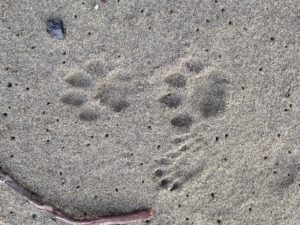
Mountain lion tracks in the sand near Maury Natural Area on Maury, September 12, 2016. Front foot registers behind the back foot. The tracks near the front foot track are raccoon for comparison. photo by: Bob Lane
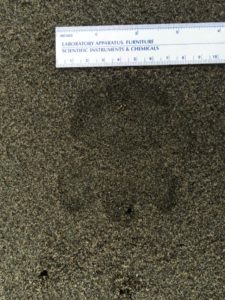
Measurements of tracks for the Maury Island cougar were about 3.25 inches wide and 3.5 inches tall indicating a cougar that is on the smaller side of the adult male range, perhaps a 20-30 month male. photo by: Bianca Perla
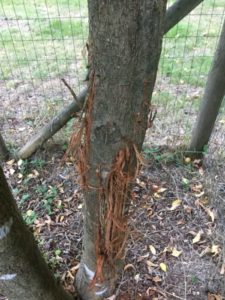
Deer rub not cougar. Notice strips are hanging predominantly from the top of the scar as deer scrape upwards. Paradise valley.
Mountain lions are felines and so they most often travel with their claws retracted. Their tracks are round shaped. In contrast dog and coyote tracks are oblong. Mountain lion tracks have a leading toe (one toe longer than the others and sticking out just slightly more). Dogs and coyotes have toes placed symmetrically around the palm pad. The palm pads of cougars are the most diagnostic when looking at a track. Palm pads have two lobes on top and three lobes on bottom. Canids have one lobe on top and two on bottom (which makes the palm pad look more triangular). Tracks measure about 3.5-4 inches in length and width. This is about the same size or just slightly larger than a large coyote or dog. More diagrams of cougar tracks. Comparison of canid and feline tracks.
Besides tracks, cougars may leave scratches on trees. We have fielded lots of questions about scratches on trees. Most often on Vashon, especially during late summer and early fall, scratches are from buck rubs. Cougar scratches present as a series of parallel lines that don’t often strip the bark but appear as gashes. Another characteristic difference is that deer rub in
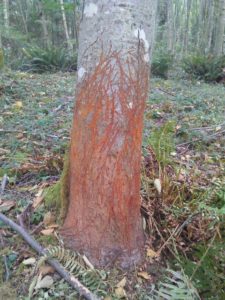
This is trickier but still a deer rub. The random assortment of scrapes is typical of deer as well as the position low on the tree. Dockton Forest.
an upward motion (predominantly) and so bark is stripped and found hanging from the top of the scar. Felines and bears scratch in a downward motion and so if bark is stripped it is mostly found hanging from the bottom of the scar. Bears tend to strip bark more than cougars. Bucks will also rub lower on the tree and often go to the ground while cougars will be centered about 4 feet-8 feet above the ground.
I keep thinking I hear a mountain lion killing something behind my house at night or screaming or calling, what do they sound like?
Mountain lions are typically silent, solitary animals. One cougar researcher told us he has been working with cougars for 17 years and only heard a cougar mating call (caterwaul) once. There are many night sounds on Vashon that can be mistaken for cougar sounds. Coyote kills and raccoon fights can sound very loud and terrible and some people attribute these to cougar kills but cougars are efficient and silent predators and rarely heard. Barn owls are plentiful on Vashon and they both scream and hiss and can sound like what we would expect a cat to sound like. Cougars actually do not scream often. They make noises that we would not associate with a cougar. For example, female cats make chirping bird like noises to their young. Cougars are the biggest cat that can still purr. The mating call (caterwauling) sounds more like wails, huffs, and sometimes screams. This is usually heard in winter and early spring in the northwest. Cougars can growl or hiss and sometimes will when defending a kill, however, this is not very common.
How many cougars are currently on Vashon and Maury?
We don’t know. Cougars are especially stealthy animals and move quickly. Because we are in close proximity to the mainland and cougars can easily swim that distance it is safe to assume that a cougar could come over at any time. The best adaptation we can have as humans is to be prepared and know our wild animal etiquette so we are aware of the actual risks, are prepared and maybe even can enjoy our sightings of cougars rather than being terrified of them.
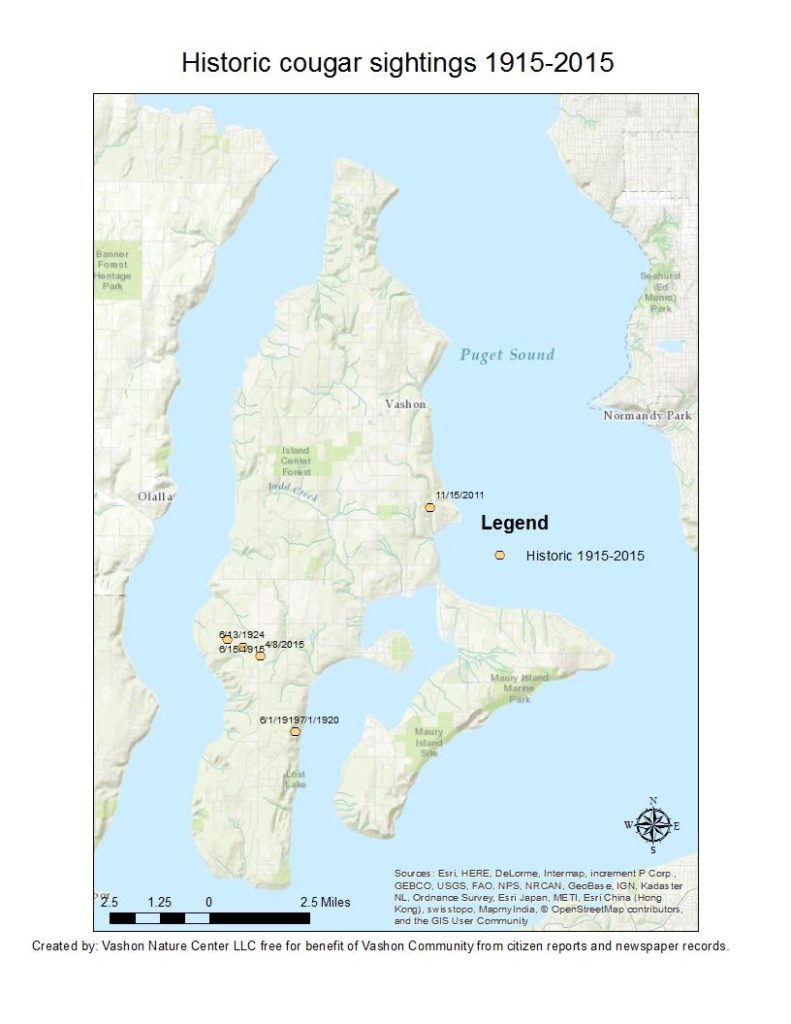
Other facts about cougars:
- There are more than 80 names for cougar in the Americas, more than any other animal
- A cougar’s tail is almost as long as it’s head and body combined
- The average weight of an adult male cougar is 150 lbs
- Cougars have exceptionally powerful legs that allow them to jump up to 30 feet from a standstill
- Cougar females are devoted parents and there is now preliminary evidence that some male cougars may come to visit their offspring with no aggression, contrary to standard belief.
- Cougars leave their mothers around 18 months old
- Female cougars often establish territories close to the mother while males disperse far away.
- Cougars in the Cascades have been found to kill deer and elk every 9-12 days.
- Male cougars can live 10-12 years in the wild. Females slightly longer.
Questions? Want to report a cougar sighting? WDFW: 877-933-9874 or Vashon Nature Center: info@vashonnaturecenter.org
featured photo: Vashon’s 2016-2017 cougar walks into Maury Island Marine Park. VNC wildlife camera capture. K Keenan.
In remembrance of the cougar who was killed on Vashon we have included a poem by Vashon Nature Center’s Outreach coordinator Kathryn True.
Eulogy for the Cougar –Aug. 15, 2017
Kathryn True
Wolverines have culture, same as people do, but they all look the same to some people because they carry it in their heads. —Elisha, Lessons from the Wolverine, Barry Lopez
Even raven is less wary now that you’re gone.
Her black eye already holds your stories,
the ones we repeat to make sense of ourselves.
You knew this island like no other will,
slipping between clay walls of forgotten ravines,
meditating on droplets from hidden headwaters,
claiming driftwood rooms under winter’s gaze.
Curiosity led you to pace our fence lines.
You didn’t distinguish between farm and field,
calculate the consequences of crossing unknown boundaries,
or comprehend forbidden prey.
Yours was the life of the nomad,
holy at its essence
for its bright-sharp edge of survival.
We are worn soft by our luxuries; instincts dulled.
We boasted of you to city friends,
flaunting our brush with wildness.
Your gift woke us to our animal place,
to remind us that we are fauna, too.
At the end, we could not tolerate you,
could not reconcile wild and tame.
In the wake of your death, we are uneasy,
our home forests surprisingly empty.
You were a bridge to the ancient.
Your presence made us pay attention—
listen, connect, wonder.
Now you haunt the late summer grasses
and visit us in our dreams,
singing in your language.
We may never know your culture,
but we can strive to understand our own,
and perhaps recover some of our own wildness,
in translating stone, creek, moon.
